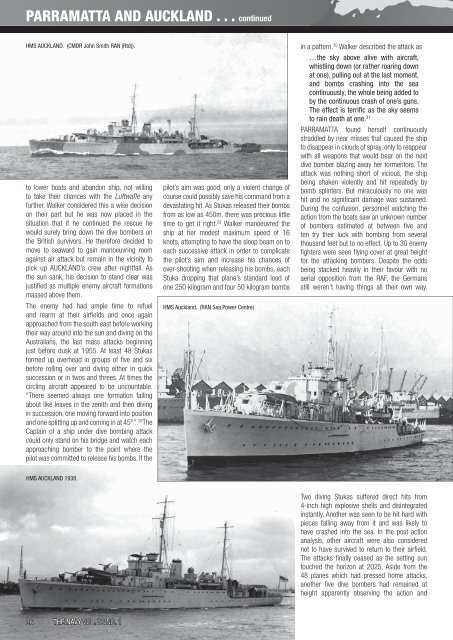JAN-MAR 2010 VOL 72 No1 - Navy League of Australia
JAN-MAR 2010 VOL 72 No1 - Navy League of Australia
JAN-MAR 2010 VOL 72 No1 - Navy League of Australia
You also want an ePaper? Increase the reach of your titles
YUMPU automatically turns print PDFs into web optimized ePapers that Google loves.
PARRAMATTA AND AUCKLAND . . . continued<br />
HMS AUCKLAND. (CMDR John Smith RAN (Rtd)).<br />
to lower boats and abandon ship, not willing<br />
to take their chances with the Luftwaffe any<br />
further. Walker considered this a wise decision<br />
on their part but he was now placed in the<br />
situation that if he continued the rescue he<br />
would surely bring down the dive bombers on<br />
the British survivors. He therefore decided to<br />
move to seaward to gain manoeuvring room<br />
against air attack but remain in the vicinity to<br />
pick up AUCKLAND’s crew after nightfall. As<br />
the sun sank, his decision to stand clear was<br />
justified as multiple enemy aircraft formations<br />
massed above them.<br />
The enemy had had ample time to refuel<br />
and rearm at their airfields and once again<br />
approached from the south east before working<br />
their way around into the sun and diving on the<br />
<strong>Australia</strong>ns, the last mass attacks beginning<br />
just before dusk at 1955. At least 48 Stukas<br />
formed up overhead in groups <strong>of</strong> five and six<br />
before rolling over and diving either in quick<br />
succession or in twos and threes. At times the<br />
circling aircraft appeared to be uncountable.<br />
“There seemed always one formation falling<br />
about like leaves in the zenith and then diving<br />
in succession, one moving forward into position<br />
and one splitting up and coming in at 45°”. 28 The<br />
Captain <strong>of</strong> a ship under dive bombing attack<br />
could only stand on his bridge and watch each<br />
approaching bomber to the point where the<br />
pilot was committed to release his bombs. If the<br />
pilot’s aim was good, only a violent change <strong>of</strong><br />
course could possibly save his command from a<br />
devastating hit. As Stukas released their bombs<br />
from as low as 450m, there was precious little<br />
time to get it right. 29 Walker manoeuvred the<br />
ship at her modest maximum speed <strong>of</strong> 16<br />
knots, attempting to have the sloop beam on to<br />
each successive attack in order to complicate<br />
the pilot’s aim and increase his chances <strong>of</strong><br />
over-shooting when releasing his bombs, each<br />
Stuka dropping that plane’s standard load <strong>of</strong><br />
one 250 kilogram and four 50 kilogram bombs<br />
HMS Auckland. (RAN Sea Power Centre)<br />
in a pattern. 30 Walker described the attack as<br />
…the sky above alive with aircraft,<br />
whistling down (or rather roaring down<br />
at one), pulling out at the last moment,<br />
and bombs crashing into the sea<br />
continuously, the whole being added to<br />
by the continuous crash <strong>of</strong> one’s guns.<br />
The effect is terrific as the sky seems<br />
to rain death at one. 31<br />
PARRAMATTA found herself continuously<br />
straddled by near misses that caused the ship<br />
to disappear in clouds <strong>of</strong> spray, only to reappear<br />
with all weapons that would bear on the next<br />
dive bomber blazing away her tormentors. The<br />
attack was nothing short <strong>of</strong> vicious, the ship<br />
being shaken violently and hit repeatedly by<br />
bomb splinters. But miraculously no one was<br />
hit and no significant damage was sustained.<br />
During the confusion, personnel watching the<br />
action from the boats saw an unknown number<br />
<strong>of</strong> bombers estimated at between five and<br />
ten try their luck with bombing from several<br />
thousand feet but to no effect. Up to 30 enemy<br />
fighters were seen flying cover at great height<br />
for the attacking bombers. Despite the odds<br />
being stacked heavily in their favour with no<br />
aerial opposition from the RAF, the Germans<br />
still weren’t having things all their own way.<br />
HMS AUCKLAND 1938.<br />
Two diving Stukas suffered direct hits from<br />
4-inch high explosive shells and disintegrated<br />
instantly. Another was seen to be hit hard with<br />
pieces falling away from it and was likely to<br />
have crashed into the sea. In the post action<br />
analysis, other aircraft were also considered<br />
not to have survived to return to their airfield.<br />
The attacks finally ceased as the setting sun<br />
touched the horizon at 2025. Aside from the<br />
48 planes which had pressed home attacks,<br />
another five dive bombers had remained at<br />
height apparently observing the action and<br />
26 THE NAVY <strong>VOL</strong>. <strong>72</strong> NO. 1

















